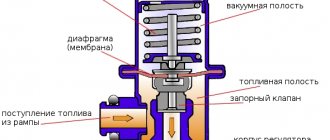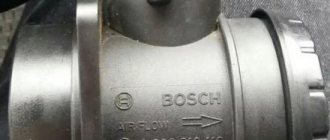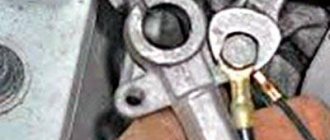Many cars manufactured since 2000, including the VAZ 2115, have electronic oil pressure sensors installed. This is an important unit whose task is to monitor the pressure generated in the oil system. If it drops or rises sharply, the sensor records the changes and reports them with a system error (a red light in the shape of an oil can lights up on the car’s dashboard). At this stage, the owner will have to diagnose the malfunction and decide whether to repair or replace the part. The article will discuss how the VAZ 2115 oil level sensor works, where it is located and how to change it.
What is this part and what is its function?
Internal combustion engines are equipped with an oil (lubrication) system that ensures uninterrupted and stable operation of rubbing parts. The oil sensor on the VAZ 2115 is a component of this system responsible for oil control. It records the pressure and if there are deviations from the norm, it notifies the driver (a lamp lights up on the panel).
The operating principle of the device is not complicated. The peculiarity of all controllers is that they convert one type of energy into another. For example, in order for it to be able to convert mechanical action, a converter of this energy into an electrical signal is built into its body. Mechanical influences are reflected in the condition of the metal membrane of the sensor. On the membrane itself there are resistors whose resistance varies. As a result, the converter “starts”, transmitting the electrical signal through the wires.
Older cars had simpler sensors, without electrical converters. But their operating principle was similar - the membrane is affected, as a result of which the device generates readings. When deformed, the membrane begins to put pressure on the rod, which is responsible for compressing the liquid located in the lubrication circuit (tube). On the other side of the tube there is a similar rod and, when oil presses on it, it raises or lowers the pressure gauge needle. On old-style dashboards it looked like this: the arrow goes up, which means the pressure is increasing, down, it means the pressure is falling.
Electronic engine control unit
The engine control unit is a kind of head control center for the entire car. This device processes all the readings provided by the vehicle’s sensors, regulates the engine control process, determines the required fuel and air ratios, generates a spark supply to the desired cylinder, and much more. The ECU is located inside the car, under the dashboard.
Where is it located?
When you have a lot of free time, you can find a lot of things under the hood if you didn’t have similar experience before. And yet, information about where the oil pressure sensor is located and how to replace it on a VAZ 2115 will not be superfluous.
In VAZ 2110–2115 passenger cars, this device is located on the right side of the engine (when viewed from the passenger compartment), namely, from the bottom of the cylinder head cover. On its upper part there is a board and two terminals powered from an external source.
Before touching car parts or diagnosing malfunctions, the car owner is recommended to disconnect the terminals from the battery in order to avoid a short circuit. When unscrewing the oil pressure sensor (oil pressure sensor), you need to make sure that the engine is cool, otherwise you can easily get burned on it.
Types of sensors and their operating principles
It is believed that in order to be able to competently replace any part on a car, you need to know its operating principle. Let's try to understand how the oil pressure sensor works and why it is needed.
As you know, a pressure sensor has a narrow membrane in its design. It is on this that almost the entire operating principle of this device is emphasized.
This membrane begins to deform under the influence of a liquid, in this case oil, and transmits information about the degree and magnitude of deflection to a special rheostat. At this time, the resistance of the rheostat also changes, which is immediately recorded by the car’s equipment and the signal is transmitted to a pressure gauge, which, in fact, shows the oil pressure in the lubrication system.
In principle, there are several types of sensors and the simplest of them are mechanical options. This is the most widely used indicator device and has a float type of operation. Direct contact is achieved with a magnetic mechanism or with a switch.
Working principle of a mechanical oil pressure sensor
As for sensors with a magnetic drive or sensors with a floating point, their switching occurs as follows: a permanent magnet located inside the structure rises or falls to the trigger level.
Pressure sensor with magnetic drive
Advice . It is not recommended to use a float sensor with a fairly high oil viscosity and in places where films or slag often form.
There are also pneumatic sensors that can control the level in almost any situation. They are, as a rule, not used in cars, but are used where there is no electricity or its use is limited.
In addition, ultrasonic sensors for measuring liquids are also known. Such sensors are capable of emitting high-frequency acoustic waves from 20 to 200 kg.
These types of sensors require proper mounting to provide the most accurate response to reflected sound.
Conductive sensors for cars are not the best choice. Most modern oils have insulating properties, which is not an option for conductive type sensors. They are used mainly in industrial enterprises.
What does a lit red indicator in the shape of a watering can mean?
Sometimes, while the engine is running, a red light comes on, accompanied by a sound signal. What does this mean:
- oil has run out (below normal);
- the electrical circuit of the sensor and the light bulb itself is faulty;
- oil pump malfunction.
After the light comes on, it is recommended to immediately stop the engine. Next, armed with a dipstick to check the oil level, check how much is left. If it’s “at the bottom” - top it up. If everything is in order, then the lamp will not light up when the engine is idling.
If everything is normal with the oil level and the light is still on, it is not recommended to continue driving. You can find the cause by checking the oil pressure.
What to do if the oil pressure sensor lights up
An oil pressure light on the dashboard is a clear sign of a problem. First of all, don't panic, start a step-by-step diagnosis.
- The lamp does not go out for a long time: the engine fluid level is below normal. Stop the engine and check the actual level with a dipstick. Replenish the missing amount. Do not exceed the maximum oil level.
- Lights up periodically when the machine is in a stationary position: the machine is tilting, due to which the DDM detects a lack of level.
- Periodic indication of an alarm while driving: the fluid level is below average, as a result of which, when entering turns, the DDM detects a lack of fluid.
- The indicator lights up for 10 - 20 seconds after starting the engine: after changing the engine oil, the indicator may light up during the first start. The process is natural, don't panic.
- The indicator is constantly on: faulty sensor, short circuit in the on-board circuit. You need to check the integrity of the circuit with a multimeter.
Pressure range 0.5 kgf/cm2 at 800 - 900 rpm.
Source
Functionality check
One of the simplest methods is to remove the sensor and, without starting the engine, crank the engine. If oil comes out of the controller installation location, then everything is fine with the pressure, but the sensor is faulty, which is why it gives a red signal. Damaged devices are considered beyond repair; moreover, they are cheap - about 100 rubles.
There is another way to check:
- Check the oil level, it should be normal (even if the indicator continues to light).
- Warm up the engine and then turn it off.
- Remove the sensor and place it in the pressure gauge.
- A pressure gauge adapter is screwed into the place where the controller stood.
- Connect the grounding of the device to the ground of the car.
- The control LED is connected to the battery positive and one of the sensor contacts (spare cables will come in handy).
- Start the engine and smoothly press the gas pedal, raising the speed.
- If the controller is in working condition, then when the pressure gauge reads 1.2–1.6 bar, the light on the control panel will go out. If not, the reason is different.
- The engine accelerates to 2000 rpm. If the device does not even show two bars, and the engine has warmed up to +80 degrees, this indicates wear on the crankshaft bearings. When the pressure exceeds 2 bar, this is not the problem.
- The turnover continues to increase. The pressure level must be less than 7 bar. If the number is higher, the bypass valve is faulty.
It happens that the light continues to light even after replacing the sensor and valve, then a full diagnostic will not be superfluous.
Ignition module
This sensor is responsible for supplying a spark to the spark plug. It has two coils, each of which supplies sparks to two cylinders. When a failure occurs, two cylinders fail at once and misfire occurs.
Signs of malfunction:
- The engine is tripping;
- Increased fuel consumption;
- Loss of power;
How to replace DDM
The process of replacing the oil level sensor is not complicated; no special knowledge is required. The tools you will need are a 21mm open-end wrench. The points:
- The front decorative trim is removed from the engine.
- The cap, also known as the boot, is removed from the controller itself, and the power is disconnected.
- The device is unscrewed from the block head with an open-end wrench.
- Installing the new part is done in the reverse order. The controller is screwed in, the wiring is connected and the engine is checked to see how it works.
Together with the sensor, the sealing ring made of aluminum will also be removed. No matter how new it is, it is better to replace it with a new one. And when connecting the electrical plug, check the condition of the wire contacts; they may need to be cleaned.
Idle speed control
A sensor that keeps the engine idling. It is a DC motor with a worm gear; there is a metal wedge on the shaft, which, if necessary, opens or closes the air channels of the throttle assembly. Installed on the throttle valve, secured with two screws to the body. Quite often it fails due to contamination of the shaft or aging of the sealing ring.
Signs of malfunction:
- Uneven idle speed;
- Long start of the internal combustion engine;
- Spontaneous engine stop;
This is interesting: Temperature sensor for VAZ 2107: where is it located, replacement
Product delivery options
Note! Below are the shipping methods available specifically for this product. Payment options may vary depending on the shipping method. Detailed information can be found on the “Delivery and Payment” page.
Parcel by Russian Post
Available payment methods:
- Cash on delivery (payment upon receipt)
- Using cards Sberbank, VTB, Post Bank, Tinkoff
- Yandex money
- QIWI
- ROBOKASSA
Shipping throughout Russia. Delivery time is from 5 to 12 days.
Parcel by Russian Post 1st class
Available payment methods:
- Cash on delivery (payment upon receipt)
- Using cards Sberbank, VTB, Post Bank, Tinkoff
- Yandex money
- QIWI
- ROBOKASSA
Shipping throughout Russia. Delivery time is from 2 to 5 days. More expensive than regular delivery by Russian Post, approximately 50%. Parcel weight up to 2.5 kg
Express Parcel EMS
Available payment methods:
- Cash on delivery (payment upon receipt)
- Using cards Sberbank, VTB, Post Bank, Tinkoff
- Yandex money
- QIWI
- ROBOKASSA
Shipping throughout Russia. Delivery time is from 3 to 7 days. More expensive than regular delivery by Russian Post, approximately 100%.
Transport companies
Available payment methods:
- Using cards Sberbank, VTB, Post Bank, Tinkoff
- Yandex money
- QIWI
- ROBOKASSA
Delivery is possible to any locality where there is a representative office of the transport company. Delivery time is from 2 to 10 days. Sending large parcels is approximately 50% more profitable than by Russian Post.
Pickup from our warehouse
Available payment methods:
- Cash upon receipt
- Credit, installments
- Using cards Sberbank, VTB, Post Bank, Tinkoff
- Yandex money
- QIWI
- ROBOKASSA
Pickup times must coincide with store opening hours.
Published 10/21/2020 Author: Iris-Auto
In the section Under the hood
Malfunctions that cause the light to come on:
- Low engine oil level
- Sensor wiring faulty
- Oil filter does not match engine parameters
- Oil pump faulty
- Insufficient oil pressure
- The sensor itself is faulty
Low oil pressure indicator.











